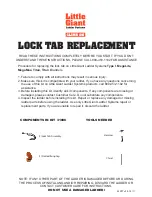
Do not step off a leaning ladder at a higher level
without additional security, such as tying off or use
of a suitable stability device;
C)
Do not use standing ladders for access to
another level;
Do not stand on the top three steps/rungs of a
leaning ladder;
D)
E)
Ladders should only be used for light work of
short duration;
Use non-conductive ladders for unavoidable live
electrical work;
Do not use the ladder outside in adverse
weather conditions, such as strong wind;
Take precautions against children playing on
the ladder;
Secure doors (not fire exits) and windows where
possible in the work area;
Face the ladder when ascending and
descending;
H)
I)
J)
K)
L)
M)
Avoid excessive side loadings e.g. drilling brick
and concrete;
Do not spend long periods on a ladder without
regular breaks
(tiredness is a risk);
Leaning ladders used for access to a higher
level should be extended at least 1 m above the
landing point;
Q)
R)
S)
Equipment carried while using a ladder should be
light and easy to handle;
Avoid work that imposes a sideways load on stan-
ding ladders, such as side-on drilling through solid
materials (e.g. brick or concrete);
Maintain a handhold whilst working from a ladder or
take additional safety precautions if you cannot;
Use the ladder in a correct way when stepping on it.
T)
U)
V)
W)
4. Repair, maintenance and
storage
Repairs and maintenance shall be carried out by a
competent person and be in
accordance with the producer’s instructions.
Ladders should be stored in accordance with the
producer’s instructions.
Keep a secure grip on the ladder when ascending
and descending;
Do not use the ladder as a bridge;
N)
O)
Wear suitable footwear when climbing a ladder;
P)


























